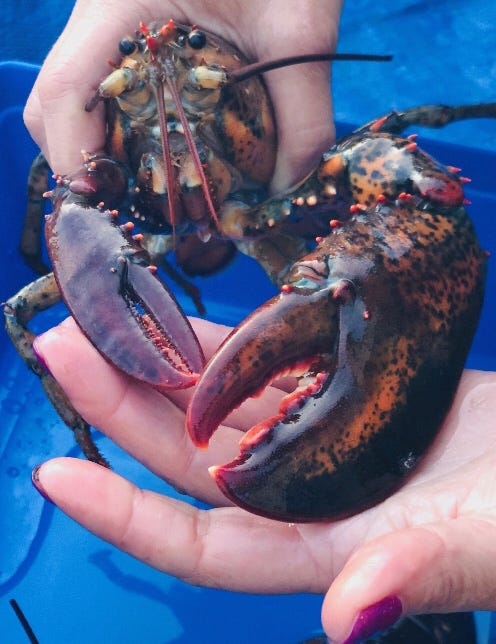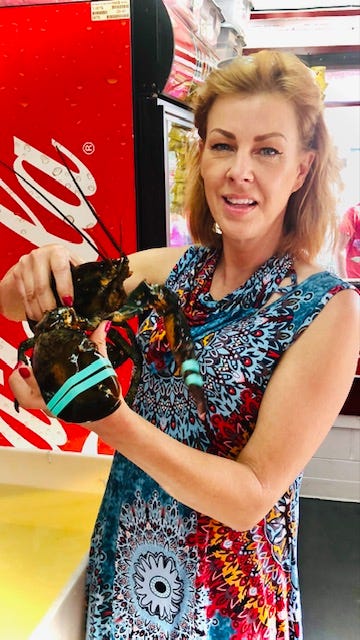THC: The High Crustaceans
If you give a lobster enough THC, will it notice that it is boiling to death?
“Imagine that you are creating a fabric of human destiny with the object of making men happy in the end, giving them peace and rest at last. Imagine that you are doing this but that it is essential and inevitable to torture to death only one tiny creature...in order to found that edifice on its unavenged tears. Would you consent to be the architect on those conditions? Tell me. Tell the truth.”
―Fyodor Dostoevsky, The Brothers Karamazov
“At heart, I’m an animal lover. I always have been,” says Charlotte Gill, the incredibly appropriately named amateur animal scientist and owner of Charlotte’s Legendary Lobster Pound, a lobster shack in Southwest Harbor, Maine.
Gill explains how when she was eight years old, she used to save her allowance money so she could visit the local lobster pound each week.
“I’d buy whatever I could,” she says, explaining that she was “saving lives.” Gill says that she would buy both crabs and lobsters, un-band their claws, walk to the end of the pier, and toss them in the ocean.
After a series of life events, which began with an undergraduate dream of a dual psychology Ph.D. and law degree, Gill ended up with her current lobster restaurant. That seems like less of an accident and more destiny for a native Mainer.
“My restaurant, which is about 10 years old, is so much more than a restaurant — it’s like a whole way of life and a hallucination, all wrapped into one,” Gill says of her special spot, which looks like a 1950’s roadside stand. It sits adjacent to an ice cream stand and a big field filled with games like life-sized Connect Four, hula hoops, stick horses, and beanbag tosses. There are also five goats. She says the crowds, which are already large, continue to grow, year after year. Though she was living her dream, there was a nagging feeling that something wasn’t quite right.
Prior to becoming a purveyor of lobster and good times, Gill was once a student at Case Western Reserve University in Cleveland, Ohio. While there, she says she read Dostoyevsky, as one does in their 20s, ensconced in the bosom of academia.
“He’s freaking awesome,” Gill says. She recites the aforementioned line from The Brothers Karamazov, saying that, even at 51 years old, it has stuck with her. “The takeaway from that, for me, is that you can build the most perfect thing that you want, but if there are elements of it that are dark or less than good, it will desecrate the entire thing,” Gill says.
In the words of David Foster Wallace, Gill began to consider the lobster, an animal that has become a culinary delicacy throughout the world, the preparation of which requires it to be cooked while still very much alive. In his famous essay, the late writer wonders, “Is it all right to boil a sentient creature alive just for our gustatory pleasure?”
Not exactly, Gill says. “Every year, it would get worse and worse for me,” she says of this nagging feeling that what was happening — the growth of her kingdom thanks to “this little creature dying an atrocious death” — was, in her own words “a certain hypocrisy.”
Gill’s anxiety reached an apex sometime around 2018, when she considered going vegetarian, took a glance at her menu, and realized she would have to change the entire thing — she does run a lobster shack, after all — and decided there might be another way. “Suffering is always going to happen, it is always here, and until we can find a way to make suffering not happen at all on any level, then we have an obligation to do it the best way we can,” she says.
One evening Gill watched the lobsters cook, gazing over them clamoring over one another, trying to crawl out of the pot as the bubbling hellbroth slowly transformed each animal from darkly-hued spidery bottomfeeders into ruby red dinnerplate centerpieces, their lives extinguished in the process.
“I thought, just because they’re in their little shells and they don’t have vocal chords, that doesn’t mean there isn’t extreme suffering happening there,” Gill says. “It’s obvious, you can see it,” she adds.
Gill may be right, though there is a lack of consensus as to exactly how or why. Some scientists maintain that because they lack specific brain anatomy, lobsters can’t actually feel pain. What could be viewed as an aversion to painful stimuli, like a lobster using its claws to find its way out of a pot of boiling water, might actually be a simple reflex.
Erring on the safe side, the Swiss government banned boiling lobsters in 2018, calling the practice inhumane and instead requiring more rapid methods of death, like stunning. The ruling was part of a larger swath of animal rights laws, which included banning puppy mills. The lobster portion was the result of a study conducted by Robert Elwood, a professor at Queen’s University in Belfast, Northern Ireland, who in a variety of studies determined that crustaceans guard wounded limbs and avoid areas where they’ve experienced pain.
For Gill, the issue is not even worth debating. After observing the lobsters one evening, she ate a “cannabis cookie” and decided to meditate. “I made a shoutout to the universe: ‘How can I make this better? I can’t in good conscience continue doing this unless there’s a better path,’” she says she remembers thinking.
Later that night, around 3 a.m., Gill “sat straight up in bed,” and said she visualized a process wherein she realized “with absolute certainty that cannabis was the answer.” By this point in our conversation, I’m thoroughly nodding along. I get it. Who among us potheads has not had some THC-tinged epiphany in the middle of the night?
Gill’s thoughts join a chorus of doctors, caregivers, and patients around the world who have been shouting for literal centuries that THC is a great tool for pain management! She figured that if she got a lobster exceptionally stoned, they could be sedated and cooked with “minimal or no stress. At least that would sedate them to the point where it would be so much better than what was happening.”
After Gill’s revelation, she and her staff performed cursory internet research. They discovered a study from New Zealand, which claimed that invertebrates have cannabinoid receptors. Though the study ended there, Gill determined that cannabinoid medicines, like cannabis smoke, should therefore have an effect on a lobster’s body.
The next question for Gill was how to administer cannabis to a lobster, which, admittedly, is hilarious to imagine. I picture a lobster sitting on a lounge chair, spindly legs in the air. It’s holding a lit joint in its big, sweet, delicious claw, which is dripping with liquefied butter because this is my dream.
Gill took a different approach with her imagination and developed an immersion apparatus. Lobsters have 12 gills on their undercarriage, which in addition to its eyes, are probably the best sites for quick absorption. She took a blue box, the type she typically uses to carry shellfish in, she says, which are about six inches deep and a foot-and-a-half long. Crucially, it had a sealed lid. In it, she placed a “few inches” of saltwater, where she rested a half-submerged lobster, gills down.
Gill and her crew then stuck a straw into a hole, completely sealed the area around it, and manually blew into the box cannabis smoke, which they had obtained from smoking a bowl (as one does). The smoke infiltrated the water and hung in the air above. As time went on, they used an air mattress pump “so we could be proper about it,” she says. The lobster stayed in the box for 3-5 minutes, which we both agreed was a decent enough hotbox session length.
“We did it many times, more than 40 or 50 times,” Gill says, saying they changed up the variables as time went on. They switched strains, which were always grown locally, and noticed a difference in the lobster’s behavior. Water temperature “did not matter one iota,” she remembers. Overall, though, she says that the lobster always appeared chilled out to the point where she felt that, at the very least, they were not exhibiting signs of stress, and therefore must have calmed. She says they observed tail flapping, and they also used a First Check drug test to test for the presence of THC, which came back negative. This is important, because it shows that there won’t be any carryover of THC into whomever might be eating it.
Regulators were not-so-thrilled to learn of Gill’s endeavors and slapped her on the wrist (today, it would be more-or-less legal to do so under Maine’s current adult-use cannabis laws). She eventually discontinued the practice of administering THC to lobsters, which she claims makes the meat taste better since the animals are less stressed when they are killed. These days, she administers valerian root to the lobsters before processing.
Word of Gill’s experiments reached the local news, where, eventually, it spread to San Diego. On May 25, researchers at U.C. San Diego published the results of their own study, which has not been peer-reviewed. “The primary goal was to determine tissue THC levels in the lobster after exposure to THC vapor. Secondary goals were to determine if THC vapor altered locomotor behavior or nociception,” the paper’s introduction reads. Nociception refers to the body’s ability to detect harmful substances in the body.
“The method of vapor exposure used in our study was selected to address the question of whether lobster gill respiration of aerosol THC would result in significant THC uptake and in behavioral effects,” says Dr. Arnold Gutierrez of the Department of Psychiatry at U.C. San Diego. “Another way one could administer THC is by injection,” he adds, detailing why they chose to follow Gill’s original blueprint in theory, if not in exact practice.
“No live lobsters were boiled in this study,” Gutierrez says. “What we did boil was a claw, after the lobster had been euthanized, to see if THC levels in cooked tissue could still be detected. THC levels were detected in boiled tissue,” he says, adding that the levels were too low to be considered intoxicating to humans should they then choose to eat the claw tissue.
Gutierrez explains that the study set out to determine three things.
“The first was to see if THC would be taken up into the lobster’s system by gill respiration. The second was to see if THC would block the perception of a painful stimulus, in this case, tail, claw, and antenna immersion in warm water ranging from 40oC-48oC. The third was to see if THC would affect lobster behavior, in this case activity,” Gutierrez says.
He confirms that THC levels in the lobster tissue confirm that THC was “indeed taken up by gill respiration.” They also noticed that the effects of THC on the lobster’s response to warm water were minimal.
When asked, “If the lobster wasn't boiling to death and was instead in the ocean, and it was high, how might it act?” Gutierrez, who is a really good sport, responded, “Based on the findings reported in the pre-print, lobster activity is decreased following aerosol THC exposure.”
While significant, because it proves that lobsters can totally get stoned, it’s not exactly proof that they don’t notice they’re boiling to death. It’s also not proof they can even feel pain in the first place.
Gutierrez and his team chose to take on this quandary because “the lobster has been used as an animal model in neuroscience research for decades. However, the behavioral effects of psychoactive substances have not been studied in the lobster,” he says. He tells me that in future studies, he thinks this invertebrate model could “potentially be used to study the behavioral effects of other drugs.”
Gill thinks the scientists should have consulted her first if only to get what she believes are the correct parameters to produce an effective study. By the time I reached her, just a few days after the study published, she had just learned that it had even been conducted.
She seemed a bit incredulous. “I was not even aware that this experiment had been recreated. How can you recreate an experiment if you don’t know how it was done at all? Except for just the basic gist of it?” she asks.
“Based on what I read of the experiment, which what was what I call, in air quotes, a ‘recreation’ of my experiment, it’s apples to oranges, a very different thing. I’m glad they tried it and saw some levels of success there, but I recommend that they do it in the fashion we did,” she says.
It’s a fair point, but it also surmises that lobsters can even feel pain in the first place. Gill, for her part, maintains this belief as absolute truth. I’ll admit that I’m still on the fence, but I do think it’s really cool that lobsters can get high as we do. I also have faith that the researchers at the university were able to develop an effective study using their own methods, and can appreciate utilizing differing schools of thought in tackling the same problem.
At the end of the day, Gill is used to people dismissing the pain and suffering of so-called lesser animals. She says she briefly considered the ethics of getting an animal high without its consent, a quandary I often kvetch over when even giving my dog CBD. She decided it was the lesser of two evils. For her, the real question is how we treat living beings, regardless of the pecking order. “I started thinking, wow, lobsters really are the least of the animals that are considered,” she says.
“If it affects the lobster,” Gill says of the pain incurred when killing animals for our sustenance, “it will affect every animal in our food supply until we can all be living on rainbows and sunshine or whatever, which is, I’m sure, lovely, if unattainable.”
Gill says that “as long as animals are in our food supply, we have an absolute obligation to dispatch in the most compassionate way possible. Jesus, if you consider the lobster, then you have to consider everything.”
Proposed alternate titles for this newsletter discussed over text with Naomi Tomky, who doesn’t even smoke weed (anymore):
Lobster Pre-Roll
Tails of the Baked Lobster
Claws and Cannabis
Crustaceans and Cannabis
Rad Lobster
Lobster Baked
Half Baked
Rocked Lobster
Things I have published recently:
It is not on the world wide web yet but in the June/July issue of Wine Enthusiast, there is a feature authored by yours truly that details the process by which those who created the appellations system for wine in the United States lent their expertise to cannabis growers, who are in the middle of creating their own system. Think of it as terroir, but for cannabis. Pick up an issue, it’s on newsstands now, which feels very vintage to say these days.
GUESS WHAT?! CANNABITCH (the newsletter) IS ONE YEAR OLD.
Thank you for being here. If you liked this, send it to someone you think would enjoy reading it. An extra special ultra big thanks to the many people who have re-upped their Cannabitch subscriptions from last year, as well as those who have become new paying subscribers. It has not been an easy year for anyone and I deeply appreciate all the support that everyone tosses my way. See you next time & smoke ‘em if you got ‘em.










Got pointed here by a link in the "What We Learned This Week" newsletter by Sara Libby of Voice of San Diego (https://www.VoiceOfSanDiego.org/topics/news/what-we-learned-this-week-319). While I love the work of all our local news teams (we are truly blessed), I secretly most look forward to the "What I'm Reading" links at the end of each VOSD newsletter as my periscope into the world outside San Diego.
And sometimes within San Diego as well! I'm glad to see such great coverage of cannabis culture and commerce. Many friends and family partake, but sadly I'm not one of them. Pot causes my blood pressure to crash and I often faint dead away. Even second-hand smoke or vape poses problems. And the recovery is mildly nauseating, on rare occasions triggering a migraine.
Still, I like to know what's going on (to keep my envy on a slow boil), and will be sharing your work with them.
How about "Stoned chef uses animal abuse to feel better about killing animals"